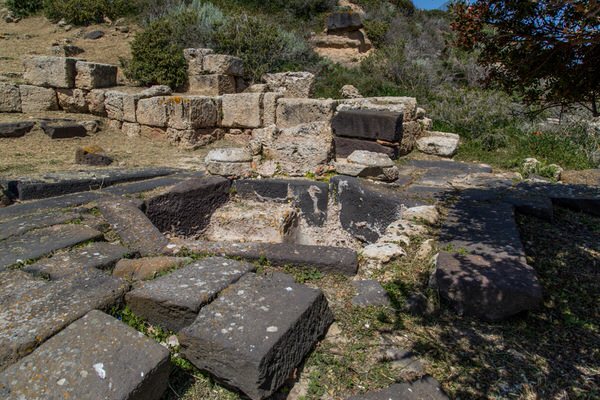The Christian baptistery
In the Late-Ancient Era, the urban layout of Tharros changed and the city split into separate centres, with the religious ones being important.
The transformation of the sector north of the Thermal baths no. 1 on the coast overlooking the Gulf of Oristano (fig. 1) is significant in this context.

In the space north of the Thermal baths, and next to them, a small complex was built in the 6th century A.D., using sandstone blocks and materials from old deteriorated buildings.
An apse can be seen in this complex with adjacent rectangular areas, and a baptesimal room (fig. 2).

The structure destined for this liturgy was also an apse and contained the hexagonal baptesimal tub (fig. 3).

A stretch of wall with the bases of two columns shows us that the tub was probably covered by a canopy (fig. 4).

Baptisms were by immersing the adult in the water, who sat in a specifically made cement chair (fig. 5).

The floor in the baptesimal room, like the tub, is made from large slabs of basalt, almost identical to the ones used to pave the roads; the slabs probably come from removing them from a stretch of road no longer used (fig. 6).

Medieval tradition places the Ecclesia San Marci in Tharros and it has been suggested that the structures north of the Thermal baths no. 1 was this church. The complex may be a clue to the presence of a small group of monks who liked in the old city centre, which was by that time almost completely abandoned. The title of Saint then gave the name to the entire peninsula, which has remained until modern times.
Bibliografia
- A.M. GIUNTELLA, Materiali per la forma urbis di Tharros tardo-romana e altomedievale, in P.G. SPANU (ed.), Materiali per una topografia urbana. Status quaestionis e nuove acquisizioni, Oristano 1995, pp. 130-139.
- P.G. SPANU, La Sardegna bizantina tra VI e VII secolo, Oristano 1998, pp. 80-85.

 VR
VR